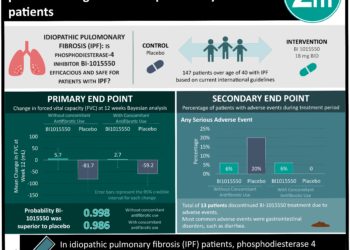Small airway dysfunction is highly prevalent in China
1. Over 40% of adults in China aged over 20 years are estimated to have spirometry-defined small airway dysfunction with no significant difference in prevalence between urban and rural areas.
2. Cigarette smoking, air pollution exposure and increase in BMI by 5kg/m2 were major modifiable risk factors associated with small airway dysfunction.
Evidence Rating Level: 2 (Good)
Study Rundown: Small airway dysfunction has been well characterized for its role in the pathophysiology of chronic lung diseases due to premature airway closure, air trapping and regional heterogeneity secondary to inflammatory changes. Given that small airway dysfunction is considered to be a precursor of chronic obstructive pulmonary disease (COPD) and asthma, measuring small airway function may be useful for identifying individuals at higher risk of developing subsequent lung disease. However, there is limited data on the prevalence of small airway dysfunction in the general population. This national cross-sectional study included 50,479 adults aged over 20 years across ten provinces in China to assess the prevalence of spirometry-defined small airway dysfunction.
Results suggested that the prevalence of small airway dysfunction was 43.5% in the general Chinese adult population, with a steady increase in prevalence with age. The risk of small airway dysfunction was significantly associated with education level, urbanization, exposure to particulate matter with a diameter less than 2.5μm (PM2.5), obesity and cigarette smoking. This study was limited by the use of spirometry to identify small airway dysfunction, which may be less accurate than imaging techniques and pathological examination. Additionally, given the cross-sectional nature of the study, there was no long-term data reported to better evaluate the associations of small airway dysfunction prospectively. A 5-year follow-up study is planned to examine longitudinal progression in this population. Future studies could also evaluate numerous other risk factors such as genetics, prematurity and bronchopulmonary dysplasia to characterise their role in the development of small airway dysfunction. Nonetheless, this study emphasizes the broad prevalence of small airway dysfunction in a national cohort, and highlights the need for further research into the detection and management of this condition to prevent long-term respiratory complications.
Click to read the study in The Lancet Respiratory Medicine
Relevant Reading: Exploring the relevance and extent of small airways dysfunction in asthma (ATLANTIS): baseline data from a prospective cohort study
In-Depth [cross-sectional study]: This study included 50479 adults (mean age 49.3 years, 42.2% male) recruited between 2012 and 2015 via a multi-stage stratified sampling method from 10 provinces, regions and municipalities across China, chosen to ensure a nationally representative sample. Participants were administered questionnaires on medical history, sociodemographic status, smoking history and other variables, as well as a physical exam including pulmonary function tests, blood pressure and anthropometry. Small airway dysfunction was diagnosed when at least two of the three indicators of pulmonary function (maximal mid expiratory flow [MMEF], forced expiratory flow [FEF] at 50% of vital capacity, and FEF at 75% of vital capacity) were less than 65% of predicted values. Small airway dysfunction was further categorized into pre-small airway dysfunction (i.e. before bronchodilation) and post-small airway dysfunction (i.e. after bronchodilation), both in the presence of a normal FEV1/FVC ratio.
The overall prevalence of small airway dysfunction was found to be 43.5% (95% CI 40.7 to 46.3). The prevalence of pre- and post-small airway dysfunction was 25.5% (95% CI 23.6 to 27.5) and 11.3% (95% CI 10.3 to 12.5), respectively. This led to estimates of 426 million adults with small airway dysfunction, 253 million with pre-small airway dysfunction and 111 million with post-small airway dysfunction in the Chinese population as of 2015. The prevalence of small airway dysfunction was found to steadily increase with age, ranging from 21.5% between ages 20 to 29 years, to 74.7% in those aged over 70 years. Notably, the risk of post-small airway dysfunction (assumed as the most reliable index) was significantly associated with cigarette smoking (adjusted odds ratio [aOR] 1.16, 95% CI 1.04 to 1.28), exposure to PM2.5 (aOR 1.21, 95% CI 1.12 to 1.44 at 50–74 μg/m³; 1.48, 1.30 to 1.69 at ≥75 μg/m³) and adiposity (aOR 1.37, 95% CI 1.26 to 1.48). Further characterization of whether small airway dysfunction and respiratory symptoms are reliable predictors of subsequent obstructive lung disease will be examined in a planned 5-year follow-up study.
Image: PD
©2020 2 Minute Medicine, Inc. All rights reserved. No works may be reproduced without expressed written consent from 2 Minute Medicine, Inc. Inquire about licensing here. No article should be construed as medical advice and is not intended as such by the authors or by 2 Minute Medicine, Inc.







